三年级英语上册第一单元
三年级英语上册第一单元知识点梳理
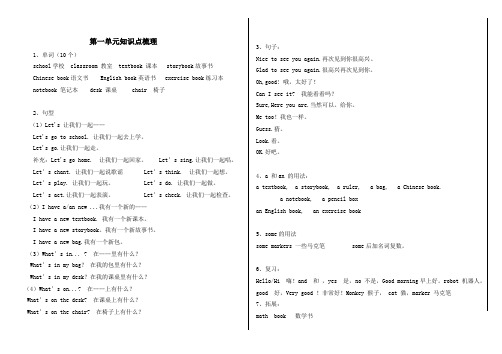
第一单元知识点梳理1、单词(10个)school学校 classroom 教室 textbook 课本 storybook故事书Chinese book语文书 English book英语书 exercise book练习本notebook 笔记本 desk 课桌 chair 椅子2、句型(1)Let's 让我们一起……Let's go to school. 让我们一起去上学。
Let's go.让我们一起走。
补充:Let's go home. 让我们一起回家。
Let’s sing.让我们一起唱。
Let’s chant. 让我们一起说歌谣 Let’s think. 让我们一起想。
Let’s play. 让我们一起玩。
Let’s do. 让我们一起做。
Let’s act.让我们一起表演。
Let’s check. 让我们一起检查。
(2)I have a/an new ...我有一个新的……I have a new textbook. 我有一个新课本。
I have a new storybook。
我有一个新故事书。
I have a new bag.我有一个新包。
(3)What’s in... ? 在……里有什么?What’s in my bag?在我的包里有什么?What’s in my desk?在我的课桌里有什么?(4)What’s on...? 在……上有什么?What’s on the desk? 在课桌上有什么?What’s on the chair? 在椅子上有什么?3、句子:Nice to see you again.再次见到你很高兴。
Glad to see you again.很高兴再次见到你。
Oh,good! 哦,太好了!Can I see it? 我能看看吗?Sure,Here you are.当然可以。
给你。
Me too!我也一样。
Guess.猜。
新版三年级上册英语第一单元
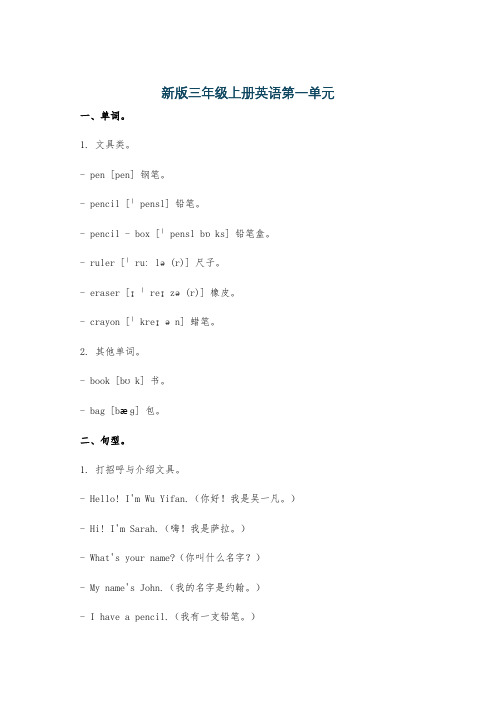
新版三年级上册英语第一单元一、单词。
1. 文具类。
- pen [pen] 钢笔。
- pencil [ˈpensl] 铅笔。
- pencil - box [ˈpensl bɒks] 铅笔盒。
- ruler [ˈruːlə(r)] 尺子。
- eraser [ɪˈreɪzə(r)] 橡皮。
- crayon [ˈkreɪən] 蜡笔。
2. 其他单词。
- book [bʊk] 书。
- bag [bæɡ] 包。
二、句型。
1. 打招呼与介绍文具。
- Hello! I'm Wu Yifan.(你好!我是吴一凡。
)- Hi! I'm Sarah.(嗨!我是萨拉。
)- What's your name?(你叫什么名字?)- My name's John.(我的名字是约翰。
)- I have a pencil.(我有一支铅笔。
)- Me too!(我也有!)2. 询问物品。
- Show me your pen.(给我看看你的钢笔。
)- Open your pencil - box.(打开你的铅笔盒。
)- Close your book.(合上你的书。
)- Carry your bag.(背上你的包。
)三、字母与发音。
本单元字母学习重点为Aa - Bb - Cc - Dd - Ee,例如:- Aa,发音为[ei],单词示例:ant [ænt](蚂蚁)- Bb,发音为[biː],单词示例:bag [bæɡ]- Cc,发音为[siː],单词示例:cat [kæt]- Dd,发音为[diː],单词示例:dog [dɒɡ]- Ee,发音为[iː],单词示例:egg [eɡ]。
三年级上册英语第一单元知识点

三年级英语上册第一单元重点知识Unit 1 Making friends 交朋友一、词汇:name名字nice 友好的ear 耳朵hand手eye眼睛mouth嘴巴arm胳膊can可以share分享smile微笑listen 倾听help帮助say说and 和goodbye再见toy玩具friend朋友good 好的二、句型:1.--Hello! I’m Mike Black. 你好,我是麦克布莱克--Hi! My name is Wu Binbin.你好,我是吴彬彬。
2.--Nice to meet you. 见到你很高兴。
--Nice to meet you, too.见到你我也很高兴。
3.Hello there! 你好。
Let’s be friends. 让我们做朋友吧。
4.Let’s shake hands. 让我们握握手。
5.Wave your hand/arm. 挥动你的手/胳膊。
Look into my eyes.看我的眼睛。
6.Point to your ear/mouth. 指指你的耳朵/嘴巴。
Hold my hand. 握住我的手。
7.-- Oh, no. 哦,不!-- It’s OK. 没关系,别担心。
8.-- We can share. 我们可以一起分享。
-- Thanks./Thank you. 谢谢。
9.--Am I a good friend? 我是一个好的朋友吗?--Yes, I am. 是的,我是。
10.I listen and say “Hi”. I smile, too. 我认真倾听并好,还微笑待人。
11.I help and share. 我乐于助人且懂得分享。
12.I play fair, too. 我还能公平公正的玩。
13.I say “Hi” and “Goodbye”. 我问好和道别。
14.I listen with care. 我认真倾听。
15.I share my toys. 我分享玩具。
三年级上册英语第一单元阅读

三年级上册英语第一单元阅读Unit1教材第2页课文翻译Zoom:Hello! I m Zoom.祖姆:你好!我是祖姆。
Mike:HeIlo,I m Mike.迈克:你好,我是迈克。
Wu Yifan:Hi.I m Wu Binbin.吴彬彬:你好,我是彬彬。
Unit1教材第3页课文翻译Zip:Hi! My name is Zip.次波:你好!我叫次波。
Miss White:Goodbye!怀特小姐:再见!John:Bye,Miss White!约翰:再见,怀特小姐!Chen Jie:Hello,I m Chen Jie. What s your name?陈杰:你好,我是陈杰。
你叫什么名字?Sarah:My namz s Sarah.萨拉:我叫萨拉。
Unit1教材A部分课文翻译Unit1Let s talk部分翻译Miss White:Hello,I m Miss White.你好,我是怀特小姐。
Wu Yifan:Hello,I m Wu Binbin.吴彬彬:你好,我是吴彬彬。
Sarah:Hi,I m Sarah.萨拉:你好,我是萨拉。
2Let s play部分翻译Hello,I m Liu Xin.好,我是刘欣。
Hi,I m John.你好,我是约翰。
3Let s learn部分翻译ruler尺子 pencil铅笔crayon蜡笔I have an eraser.我有一块橡皮。
I have a ruler.我有一把尺子。
4Let s chant部分翻译I have a ruler.Me too!我有一把尺子。
我也有!I have a pencil.Me too!我有一支铅笔。
我也有!I have a crayon.Me too!我有一支蜡笔。
我也有!I have an eraser.Me too!我有一块橡皮。
我也有!5Let s sing部分翻译A B C song字母歌Aa- Bb- Cc- Dd- Ee- Ff- Gg,Aa-Bb-Cc-Dd-Ee-Ff-Gg,Hh- Ii- Jj- Kk- Ll- Mm- Nn,Hh-Ii-Jj -Kk-Ll-Mm-Nn,Oo- Pp- Qq, Rr- Ss- Tt,Oo-Pp-Qq, Rr-Ss-Tt,Uu- Vv- Ww- Xx- Yy- Zz.Uu-Vv-Ww-Xx-Yy-Zz。
三年级英语上册一单元
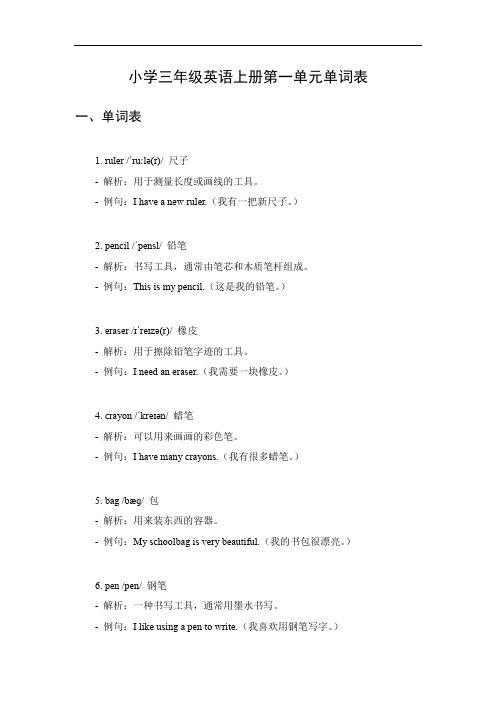
小学三年级英语上册第一单元单词表一、单词表1. ruler /ˈruːlə(r)/ 尺子-解析:用于测量长度或画线的工具。
-例句:I have a new ruler.(我有一把新尺子。
)2. pencil /ˈpensl/ 铅笔-解析:书写工具,通常由笔芯和木质笔杆组成。
-例句:This is my pencil.(这是我的铅笔。
)3. eraser /ɪˈreɪzə(r)/ 橡皮-解析:用于擦除铅笔字迹的工具。
-例句:I need an eraser.(我需要一块橡皮。
)4. crayon /ˈkreɪən/ 蜡笔-解析:可以用来画画的彩色笔。
-例句:I have many crayons.(我有很多蜡笔。
)5. bag /bæɡ/ 包-解析:用来装东西的容器。
-例句:My schoolbag is very beautiful.(我的书包很漂亮。
)6. pen /pen/ 钢笔-解析:一种书写工具,通常用墨水书写。
-例句:I like using a pen to write.(我喜欢用钢笔写字。
)7. pencil box 铅笔盒-解析:用来装铅笔、橡皮等文具的盒子。
-例句:My pencil box is pink.(我的铅笔盒是粉色的。
)8. book /bʊk/ 书-解析:供阅读或学习的印刷品。
-例句:I have an English book.(我有一本英语书。
)二、记忆方法1. 实物记忆:拿出这些文具的实物,让学生观察并说出对应的英文单词,加深记忆。
2. 游戏记忆:可以通过“猜单词”等游戏,让学生在轻松愉快的氛围中记忆单词。
比如一个学生拿出一种文具,其他学生用英语说出这个文具的名称。
3. 重复记忆:多读多写这些单词,在不同的时间重复记忆,巩固印象。
三、拓展练习1. 单词拼写:老师说出中文意思,学生拼写对应的英文单词。
2. 单词连线:将单词和对应的图片进行连线。
3. 用所学单词造句,如“I have a ruler.”“My bag is blue.”等。
三年级上册英语全册
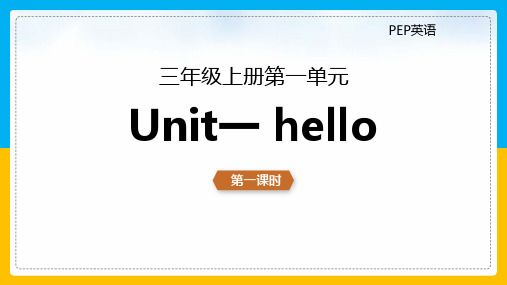
重点句型2
Let's go to school 我们一起上学吧! — OK! 好的!
句型结构:Let's+动词原形+其他.
详解 let's是let us的缩写us的意思是我们, let's包括说话人和听话
人双方,含有催促、建议或对方一起行动的意思,
例句 Let'sgo home.我们一起回家吧
Homework
三年级上册第二单元
Unit二 Colours
第二课时
Let's learn
Isee green.
Isee red.
see 动词看见
例句
Isee two pens. 我看见两支钢笔
red yellow
green blue
red/red/红色;红色的; yellow /ˈjeləʊ/黄色;黄色的 green /ɡriːn/绿色;绿色的; blue /bluː/蓝色;蓝色的
表示颜色的词可以作名词,意 为……色;还可以作形容词,意为 “……色的”
例句 Ilike green. 我喜欢绿色
I have a yellow bag. 我有一个黄色的包,
Homework
PEP 英语
三年级上册第二单元
Unit二 Colours
第三课时
Letters and sounds
ant
重点句型:一. How are you 你好吗 — I'm fine, thank you. 我很好,谢谢你 二.Let's go to school 我们一起上学吧! 三.Look at me! 看我! 四.This is my face. 这是我的脸,
Homework
(新教材)三年级上册英语第一单元复习要点
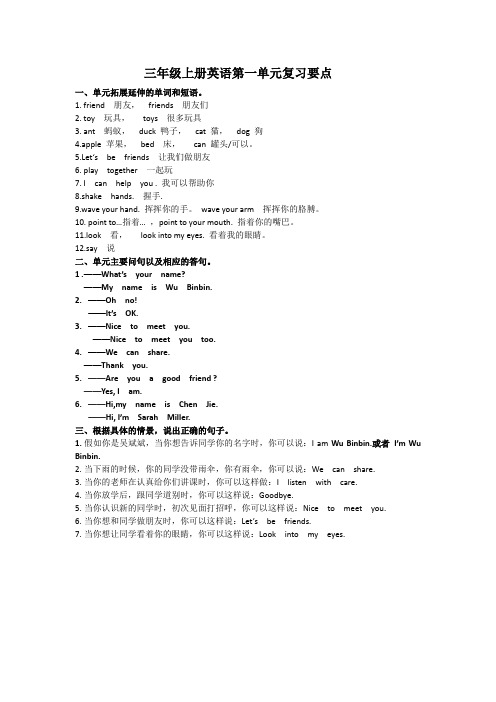
三年级上册英语第一单元复习要点一、单元拓展延伸的单词和短语。
1. friend 朋友,friends 朋友们2. toy 玩具,toys 很多玩具3. ant 蚂蚁,duck 鸭子,cat 猫,dog 狗4.apple 苹果,bed 床,can 罐头/可以。
5.Let‘s be friends 让我们做朋友6. play together 一起玩7. I can help you . 我可以帮助你8.shake hands. 握手.9.wave your hand. 挥挥你的手。
wave your arm 挥挥你的胳膊。
10. point to…指着… ,point to your mouth. 指着你的嘴巴。
11.look 看,look into my eyes. 看着我的眼睛。
12.say 说二、单元主要问句以及相应的答句。
1 .——What’s your name?——My name is Wu Binbin.2.——Oh no!——It’s OK.3.——Nice to meet you.——Nice to meet you too.4.——We can share.——Thank you.5.——Are you a good friend ?——Yes, I am.6.——Hi,my name is Chen Jie.——Hi, I’m Sarah Miller.三、根据具体的情景,说出正确的句子。
1.假如你是吴斌斌,当你想告诉同学你的名字时,你可以说:I am Wu Binbin.或者I’m Wu Binbin.2.当下雨的时候,你的同学没带雨伞,你有雨伞,你可以说:We can share.3.当你的老师在认真给你们讲课时,你可以这样做:I listen with care.4.当你放学后,跟同学道别时,你可以这样说:Goodbye.5.当你认识新的同学时,初次见面打招呼,你可以这样说:Nice to meet you.6.当你想和同学做朋友时,你可以这样说:Let’s be friends.7.当你想让同学看着你的眼睛,你可以这样说:Look into my eyes.。
PEP小学英语三年级上册第一单元教案(五篇范文)

PEP小学英语三年级上册第一单元教案(五篇范文)第一篇:PEP小学英语三年级上册第一单元教案PEP小学英语三年级上册第一单元教案三年级上册第一单元单元教学目标与要求1.能听懂,会说Hello./ Hi.Goodbye./ Bye-bye.I'm....What'syour name? My name's...., 并能够在实际情景中进行运用。
2.能够听说、认读crayon, pencil, pen, eraser, ruler,pencil-case, book, sharpener, bag, school,并能用英语介绍文具。
3.能听懂所接触的指示语,并能按照指令做出相应的动作。
第一课时一.教学内容与分析 1.Let’s talk本部分主要是会话学习。
通过见面打招呼,自我介绍以及道别等情景,让学生在模仿、学习、表演的基础上逐步达到自然交流与真实运用的目的。
2.Let’s play本部分让学生在游戏活动中熟练运用所学问候语及自我介绍用语。
二.课前准备1.将教师用书后所附的本套教材主要人物的图片复印或剪下,涂色后制成头饰。
2.为班上学生准备出男女生常用的英文名字(可参考本书后的附录)。
3.为Let’s play中的击鼓传花游戏准备相应的道具。
三.教学步骤与建议 1.热身(Warm-up)由于学生是第一次正式接受英语课的学习,教师有必要采取交谈的方式与学生讨论一下英语的作用以及学习英语的意义。
不妨请学生说说他们在现实生活中已经了解的英语词汇或日常用语。
同时可利用本教科书开头的蝴蝶页WelcometoEnglish彩图中呈现的我们生活中学生已经会说或较熟知的词汇如TV,CD,VCD,DVD,OK!Hi!Yeah!Bye!Cool!Wow!E-mail,cartoon等等来激发学生想学英语的兴趣和愿望。
此部分的教学可参考致教师中第七部分(一)上好导言课的教学建议。
2.新课展示(Presentation)教师可播放本课的歌曲“Hello”的录音,自然引出师生之间的打招呼。
- 1、下载文档前请自行甄别文档内容的完整性,平台不提供额外的编辑、内容补充、找答案等附加服务。
- 2、"仅部分预览"的文档,不可在线预览部分如存在完整性等问题,可反馈申请退款(可完整预览的文档不适用该条件!)。
- 3、如文档侵犯您的权益,请联系客服反馈,我们会尽快为您处理(人工客服工作时间:9:00-18:30)。
个性化教学辅导教案
首课
一.观看ABC song 视频,一起跟着唱。
二.自我介绍并和老师相互问好。
三.给图选择对应的单词,将序号填入括号。
1.学会用英语自我介绍和同伴相互问候的句型。
2.掌握学习文具的单词。
3.学会ABC song,为接下来26个英文字母的学习有个初步的印象。
一.重点单词
学习文具:pen (钢笔) pencil (铅笔) pencil-box ( 铅笔盒) ruler(尺子) eraser(橡皮) crayon (蜡笔) book (书) bag (书包)
no(不)your(你的)
二.重点句型
牢记下面的对话,会让你的英语说得更棒!(A是上句,B是答句) 1、向别人问好应该说――A: Hello! (你好!)
B: Hi! (你好!)
2、问别人的名字应该说-――A:What’s your name?你叫什么名字?
B:My name’s Chen Jie.我的名字是陈洁。
3、跟别人分手应A: Bye.\ Good bye!(再见)
B: See you.(再见) \ Goodbye.(再见)
4、A: I have a ruler\an eraser 我有一把尺子\ 一块橡皮。
B: Me too . 我也有。
5、A: Who’s there? 谁在那儿?B:Guess! 猜!
6、A: Are you TuTu? 你是图图吗?B: No! 不是!
读读,记记下面的句子并做出相应的动作。
你会很棒的!
1.show me your pen. 让我看看你的钢笔。
2.open your pencil--box. 打开你的铅笔盒。
3.close your book .关上你的书。
4.carry your bag. 背起你的书包。
一.看一看,找一找。
将单词的序号写在图片下面(8分)
A.pencil B. ruler C. crayon D. book
E. pen
F. eraser
G. bag
H. pencil-box
二.读一读,选出每组中不同类的一项(5分)
()1. A. crayon B. open C. book
()2. A. hello B. bye C. hi
()3. A. Mike B. John C. pencil
()4. A. show B. carry C. bag
()5. A. goodbye B. bye C. close
一.读一读,圈出正确的单词(6分)
二.根据单词选择正确的汉语意思(5分)
( ) 1. hi A.你好 B.再见 C.永远
( ) 2. crayon A.铅笔 B.蜡笔 C.钢笔
( ) 3. goodbye A.尺子 B.再见 C.名字
( ) 4. eraser A.铅笔 B.文具盒 C.橡皮
( ) A.爱好 B.名字 C.同学
一.单项选择(10分)
( )1.----Hello! ----___. A. Hello! B.Hi! C.Ha! ( )2.----Goodbye, Miss White! ----___. A.Bye, Mr Black! B. OK! ( )3.----What’s your name? ----___.
A.My name is Sarah.
B. Goodbye, Sarah!
( )4. I have a book. -----___! A. Hello! B.Me too!
( )5.----Let’s play! ---- ____! A.Bye B. Goodbye C.OK
( )6. I have a ____ (铅笔). She has a __(钢笔).
A.pencil; pencil
B.pen; pencil
C.pencil; pen
( )7. ----Happy Teachers’ Day! ---- . A.Me too B.Thank you
( )8.Show me your__(铅笔盒). A.pen B.pencil C.pencil box ( )9.----Bye, Sarah. ---- . A.See you! B. I’m Sarah.
( )10.---- ___? ----I’m Bai Ling. A.Ok B.What’s your name
二.从B 栏中选择A 栏各句的正确答语。
(5分)
A B
()(1)Bye! a. Hi! I’m Sarah.
()(2)What’s your name? b. See you.
()(3)Hello! I’m Wu Yifan. c. My name’s Chen Jie.
()(4)Goodbye,class. d. Bye, Miss White.
()(5)I have a pen. e.Me too!
课后作业:
一.根据情景选择正确的答案,把序号填在括号内。
(10分)
1.当你想知道对方的姓名时,你可以这样说:()
A.Hello ! I’m John . B. Hello! What’s your name ?
2.你想告诉对方自己的姓名时,你可以这样说()
A.What’s your name ? B. Hi! I’m Chen Jie .
3.当你遇见好朋友时,可以用()打招呼! A. Goodbye ! B. Hello !
4.放学了,你对好朋友说() A. Hi ! B. Bye !
5.你有一把尺子,你想告诉好朋友,应该用英语()表达。
A. I have a ruler .
B. I have a pen .
6.你的好朋友有一块漂亮的橡皮,你也有,可以用()表达。
A. Me too .
B. I have a pen .
7.“打开你的书。
”用英语表达是()
A. Open your book .
B. Close your book .
8. “背上你的书包。
”用英语表达是()
A.Show me your bag . B. Carry your bag .
9. “让我看看你的铅笔盒”用英语表达是()
A. Show me your ruler .
B. Show me your pencil-box .
10. “Close your book .”的中文意思是()
A.打开你的书。
B. 合上你的书。
二.将图片中的人物与物品连线(10分)
Sarah: Hello, my name is Sarah. I have a pencil-box .
Chen Jie: Hi, I’m Chen Jie. I have a ruler .
Zoom: I’m Zoom , I have a pencil and a book .
Zip : I’m Zip. I have an eraser and bag .
Mike: I’m Mike. I have a crayon and pen .。
